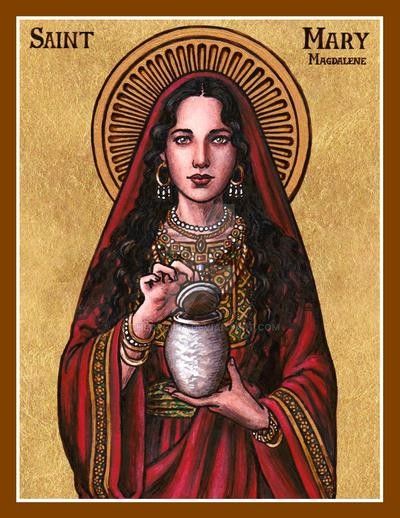Mary Magdalene is a living teacher, available to us now, showing us how to stand in the midst of our embodied lives and the cosmos. We can learn to occupy her inner posture in our bodies (movement center), emotional landscape and attitudes (feeling center), and thought patterns (intellectual center). One of the most striking postures she reveals to us is that of wielding a spiritual fruit or substance, bringing it forth as a force for ourselves and for another. This wielding and bringing forth substances as forces is something that Cynthia Bourgeault has been teaching for many years now. Mary Magdalene did not just look to receive from and have her needs met by Jesus as his follower and disciple, but also saw what was needed and brought it forth from within and beyond. Spiritual fruit or substances which include courage, faith, hope, love, joy, peace, patience, kindness, goodness, self-control, perseverance, forgiveness, gratitude, trust, etc. She did this again and again throughout the passion drama beginning with her courageous loving act of anointing Jesus’ feet.

She was able to remain and to wield presence and tenacious, kind, fierce love. In The Meaning of Mary Magdalene, Cynthia points out that every time Mary Magdalene enters the picture, she brings forth the forces of forgiveness, tenderness, gentleness and longing (p.159). When many of Jesus’ friends and followers betrayed him, overcome by their valid instincts for survival, Mary Magdalene did not. She remained standing vigil, wielding courage and strength, and offering her presence as a force throughout the entire week. And because of this, despite what has often been portrayed, Jesus did not die alone. In The Wisdom Jesus, Cynthia says, “it is important to remind ourselves that Jesus did not actually die alone. Though this fact is never mentioned in the Holy Week liturgies of the West, all four gospels make perfectly explicit that Mary Magdalene was there by the cross throughout the entire crucifixion and for the burial as well. It is entirely possible that she never left the site, or at best left it only briefly, to return in short order with her two fellow Marys’ and the burial ointments on Easter morning. What the other disciples could not manage, she offered effortlessly: an unbroken witness to the power of love itself holding all things together” (p.119).
Mary Magdalene also had to stand firm in her center and not bend in the midst of one of the greatest struggles of her life—watching Jesus be crucified right in front of her. Although one can never fully be prepared for something like what she experienced, it is important to remember that she had done her inner preparatory work. She, like Jesus, had faced her and her ancestral shadow. Cynthia points out how Jean-Yves Leloup suggests in his commentary that the fact that seven demons were cast out of her means she had done her psychological work (p.14). She had tamed her ‘inner beasts’ and confronted the passions within her that enchained her as a human being to the powers of this world. The arising from this work was “not only psychological wholeness, but the capacity to see. Her clear heart is her intimate channel to the fullness beyond time” (p.68). She had learned to be sturdy as a tower that would not topple over.
From that place she was able to remain, offering love and witness, holding Jesus’ “tether like falcon in falconer as he descends into the underworld. The sheer tenacity of her presence is not a result of ordinary human Courage, or even the detached equanimity of one who has attained to his level of mastery. It is an active substituted love, as instant by instant she gives herself that he might be well. . . so that he might travel freely to accomplish the cosmic task he has been given to do” (The Meaning of Mary Magdalene, p.154).
As we step into this posture with Mary Magdalene, we can open to the possibility of doing the same. Pause and reflect, as Cynthia has often suggested, on what it might mean for you to “wield” these substances rather than merely “receive” them. . . to bring them as forces rather than as a reaction to life or looking to life to draw them out of you. . . even when there is no external confirmation that they are warranted. How could this impact your life? What new imaginative possibilities might this open up?
With Great Love, Heather
Ready to Go Deeper with Mary Magdalene?
Cynthia Bourgeault’s course, “Mary Magdalene: Apostle to Our Own Times,” is now open for registration at the Center for Action and Contemplation. This eight-week course begins April 10, 2024. Read more details and register here.
Mary Magdalene Course
